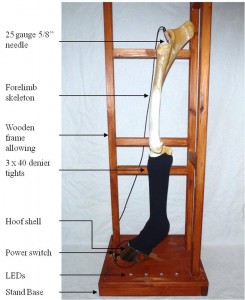Equine lameness constitutes a large proportion of an equine clinician’s caseload and performing diagnostic nerve blocks is an essential skill for equine practitioners. However the opportunities for veterinary students to practice this skill are limited. Traditionally, equine diagnostic analgesia is taught with the use of equine cadaver limbs. However, due to economical, logistical implications, in conjunction with the increase in the number of veterinary students, and ethical reasons, the use of cadavers is becoming increasingly more difficult.
In a paper recently published in Veterinary Record, a team of researchers from the Royal Veterinary College in London, UK, designed an equine nerve block simulator using an equine forelimb skeleton and expanding foam, which was carved to mimic the shape of the soft tissues.1 Wire wool targets were placed under the foam in the positions corresponding to the anatomical location of the palmar digital, abaxial and low four point nerve blocks and attached to an electric circuit and a buzzer, which provided auditory feedback when the needle had been placed correctly and the closed the electric circuit.
In order to validate the simulator, third-year undergraduate veterinary students were randomly assigned to one of three groups: the cadaver group, which received training in a 45 minute cadaver session, the simulator group, which received training using the nerve block simulator and the hand-out group, which was given a handout and a textbook to study. Students from all groups were asked to return one week later to demonstrate what they had learned on an equine cadaver forelimb.
Taking all the nerve blocks together, the cadaver group demonstrated the highest accuracy (73 per cent), followed by the simulator group (71 per cent) and the handout group (58 per cent). Feedback from the students showed that those in the simulator group enjoyed their training more and felt more confident in performing the technique than the other two groups.
The authors conclude that the nerve block simulator enabled students to learn how to perform diagnostic analgesia in the equine distal limb with a similar proficiency to traditional cadaver limb training. They add that this safe, cost-effective method also allows students to repeatedly practice skills with ease and could be a useful supplement the teaching of diagnostic nerve blocks to undergraduate veterinary students.
Follow this link to watch the simulator in use!
References:
